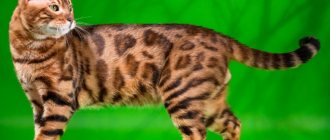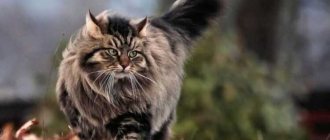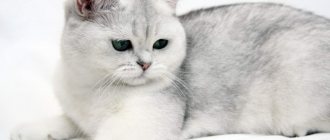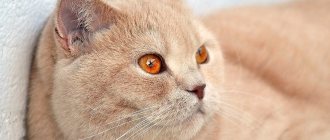This unique breed has many advantages that a person may not even be aware of. The photo of an oriental cat does not look quite ordinary.
At first glance, the appearance of thin cats with long ears may seem comical, but in fact, representatives of this breed have a wonderful character that owners cannot help but like.
A little history
In the 19th century, the Siamese cat became a guest at an English exhibition, where its appearance became a real sensation.
Later, breeders began crossing Siamese with female shorthaired breeds. This is how the Oriental cat breed was developed.
Application
Oriental cats are brought into the home so that they have someone to play with, vent to, and just cuddle with. And at the same time, do some training - which is not a reason to surprise your guests.
The Oriental cat, like all cats, is sure that the world was created for them, and therefore will meow, trying to attract attention. Although their voice is quite pleasant and melodic, unlike Siamese cats
Breed standard
- Torso. The animal is of medium size and has a thin constitution. Its body is elongated with well-developed muscles, its tail is thin, and its legs are high.
- Head. The breed is characterized by a flat forehead, a thin and elongated nose, and a narrowed chin. The muzzle has an elongated, wedge-shaped shape.
- Ears. They are large in size, with a wide base that becomes pointed at the ends.
- Eyes. Slanting, almond-shaped, green.
- Wool cover. The coat is short and shiny, there is no undercoat.
- Color. All kinds of varieties except white.
Appearance and standards
Orientals have a variety of coat colors, and in most cases they have green eyes. Nevertheless, they stand out among other felines due to their deceptive fragility, glossy beauty and the enchanting gaze of their slanted eyes. Elongated features and some angularity of the body add elegance to them.
According to the standards, the dimensions of the body are embodied in the following average indicators:
- the weight of a cat varies from 2.5 to 3.5 kg, and that of a cat – up to 4.5 kg;
- body height at the withers is approximately 20-25 cm;
- body length with tail reaches 90 cm;
- normal weight for a female is 2.3-3.2, and for a male – 3.7-4.5 kg, sometimes up to 6-8 kg.
Excess weight is contraindicated for such pets, as it can greatly worsen their health. Well-developed muscles are the key to the activity and health of the animal, as well as one of the distinctive features of the species.
Head and muzzle
The triangular head of an oriental cat corresponds to the following parameters:
- Elongated muzzle with a narrow chin and flat forehead. Connects to the body with a thin long neck.
- The eyes are of medium size, inclined towards the nose, have an almond-shaped cut, without strabismus. The color ranges from light to dark green and even marsh green, blue in white cats, heterochromia is allowed.
- A straight, elongated nose continues the line of the forehead, and at the end it visually connects straight to the line of the chin. Snub nose is a defect, as are dimples between the eyes.
- The ears are large and wide at the base, tapering and rounding towards the tips. Planted low and spaced apart. They are a natural extension of the head, bringing its shape closer to an equilateral triangle.
Body type
It’s not for nothing that the Oriental has the grace of a panther; this is due to the following structural features of the body:
- a torso with a thin skeleton, well-developed muscles and a toned abdomen;
- cartilage protrudes noticeably on the chest;
- the limbs are slender and strong, ending in miniature paws, the hind limbs are longer;
- the long tail tapers towards the end.
Coat and colors
Initially, Oriental cats were smooth-haired, with shiny, tight-fitting hair. They can have any color, in a color range of up to 300 shades, which were grouped into the following color groups:
- ebony (black);
- Havana (chocolate);
- lilac (pink-gray, lavender shade);
- blue (gray, silver);
- faun (light gray with beige);
- red (red);
- cream or cinnamon (light brown);
- white (rarest).
In addition, there are the following color variations:
- solid one color;
- bicolor (almost half and white);
- harlequin (white with large spots of color);
- van (snow-white, with small spots on the head and tail);
- Siamese (cream base with dark ears, muzzle and legs);
- tabby (brindle, spotted, marbled, ticked types);
- smoky (the light undercoat is shaded on top);
- tortoiseshell (primary color with red or cream shades);
- calico (chocolate tortoiseshell with white).
Long-haired Oriental cats: a new breed or a recognized variety?
At the end of the last century, breeders bred longhaired Orientals. As a result, their lines softened and their features became cuter, less like a predator and more like a pet. But felinological organizations recognized them only partially:
- TICA (Traditional Owners in America) calls them a variety of Oriental cats;
- FIFE (International Felinological Organization) and CFA (Cat Fanciers' Association) distinguish them into a separate breed, the Javanese;
- some American associations compare them to the Balinese, and the British - to the Siamese.
Oriental and Siamese cat
Orientals are descended from Siamese and are often crossed with each other to improve their characteristics. This produces a mixed litter, whereas two Siamese will only produce Siamese.
It is quite simple to distinguish them: the Oriental Siamese has green eyes, which is the main distinguishing feature.
Only snow-white cats will have blue eyes, like Siamese. Otherwise, they are all green-eyed, although individuals with different iris colors are less common. Previously, felinologists considered this a marriage, but since then the requirements have been revised.
Characteristics of a pet
An owner who wants to get a pet will need the following information: the character and description of the oriental cat.
These energetic animals have a good disposition. Cats are trusting of people and quickly become attached to them. If the owner takes care of his pet, then he will always be surrounded by boundless love.
A sociable cat requires a lot of attention. If a person is constantly busy, he should not choose such a pet. Or he can get a couple of cats at once; the two animals will not be bored.
Among the characteristics of the breed, one can note a gentle voice; pets love to talk with people. Cats are always in a great mood and are ready to play with their owner as soon as he has free time.
Adult pets remain energetic and active throughout their lives. If you take a kitten into your home, it quickly finds a common language with other pets.
How to choose a kitten
When buying an Oriental breed kitten, be sure to ask about its age. Nurseries that value their own reputation do not sell animals that are under 3 months old. When assessing the conditions in which babies are kept, pay attention to whether the breeder has cages in which unscrupulous sellers often lock their charges. Experienced specialists who love their work raise kittens in a home environment: they play with them, they are not put in an enclosure and are not limited in communication with other pets. Accordingly, such individuals will undergo socialization faster.
Oriental kittens with mother
Its appearance will also help to assess the health of an Oriental kitten. Eared cats with matted fur, discharge from the eyes and nose, and bloated bellies will bring nothing but problems. Any kitten purchased from a cattery must have a metric or pedigree. If there are none, then, most likely, under the guise of a purebred Oriental, they are trying to give you a mestizo. Sometimes breeders explain the lack of documents for a kitten as an unplanned mating, although this is nothing more than excuses and attempts to hide the truth about the true origin of the animal.
Those who plan to breed their pet in the future and get offspring from it should look into nurseries that sell breed-class oriental cats with impressive pedigrees. If you do not intend to breed kittens for sale, visit places where they breed orientals without breeding rights. Most of these nurseries offer already castrated or sterilized kittens.
Some breeders have a negative attitude towards early sterilization, which can seriously affect the external parameters of the cat, and do not carry out this procedure. In this case, all responsibility for the reproductive function of the pet falls on the future owner. Usually, before the sale, the buyer signs an agreement according to which he undertakes to spay/neuter the kitten as soon as it is 8-12 months old.
How to care for your pet
Owners should not devote much time to representatives of this breed. Short hair is easy to comb; you should start brushing from the head towards the tail.
It is recommended to bathe cats for preventive purposes. This needs to be done every year.
Features of feeding and diet
Due to the imperfection of the digestive system of Orientals, it is better not to experiment with the selection of natural food and choose industrial high-quality options. The main thing is not to mix dry and wet food during the same meal.
One of the main indicators characterizing properly selected food is the condition of the coat. It will be silky to the touch, soft and shiny. If dandruff or excessive hair fragility occurs, you should think about reviewing your diet.
How to take care of your eyes
Orientals wipe their eyes daily to remove all discharge.
The procedure is performed using a cotton swab or a piece of soft material, which is pre-moistened in water or tea leaves.
Health
Characteristic diseases
Orientals are healthy cats, but the relationship with the Siamese breed explains the occurrence of cardiomopathy (heart), gingivitis (mouth and teeth) and amyloidosis (inherited).
Vaccinations
It should be noted in the veterinary record that vaccinations were given at the ages of 9 and 11. Then you need to come for vaccination once a year.
Don't miss your kitten's first vaccination . Don’t forget to get rid of worms before visiting the veterinarian (1.5 weeks before the visit).
Color is the basis of the breed. Therefore, you can only breed cats and female cats of one type of breed and one color.
How to care for your ears
The animal's huge ears require special attention. An oriental black cat or a pet with a different color has delicate skin, so rough manipulations are not acceptable.
For the cleaning procedure, prepare soft cotton swabs intended for hygiene procedures, Vaseline or oil. Do not make rough movements or press on the ears.
Care
The Oriental's short, soft, black, gray or brown coat, which has no undercoat, looks clean for a long time, sheds rarely, does not tangle, and therefore does not require regular brushing.
You shouldn’t bathe your cat often, otherwise you can dry out the skin, and the black or other dark-colored fur will become faded. For brushing once a month, it is better to use a silicone brush.
The ears are wiped with veterinary ear lotion 2 times a month, making sure there are no black spots inside - a sign of a tick. The claws are shortened with a similar frequency using a nail clipper. The teardrops of the eyes are wiped daily with a napkin moistened with boiled water.
Oriental is an indoor breed that does not require walking. But if you want to walk your animal, then only on a leash in warm weather.
How to care for claws
It is recommended to cut your nails every month. To avoid causing pain to your pet, you should trim a maximum of 2 mm.
For the procedure, use sharp nippers; accustom the kitten to nail hygiene from the moment it appears in your home; trim one nail per week.
Diseases and their prevention
From relatives - Siamese cats - the Oriental received a bouquet of hereditary diseases:
- Hepatic amyloidosis, which, if not treated in a timely manner, causes organ failure.
- Dilated cardiomyopathy.
- Progressive retinal atrophy.
- Flattened chest syndrome. A terrible disease that leads to the death of a newborn kitten. Due to the deformation of the chest, the lungs cannot function normally, and the animal suffocates.
The Oriental is well fed and protected from drafts, since due to the lack of undercoat it is prone to colds.
Important! To prevent cardiomyopathy, the animal undergoes an ultrasound every six months.
The Oriental is regularly taken to the veterinarian for routine checkups. Vaccinations are carried out annually against rhinotracheitis, panleukopenia, rabies, calcivirosis, and if the animal is involved in breeding, then against chlamydia. A week before vaccination, the cat is given an anthelmintic drug.
Contents of orientals
Before you get a pet, you will need to make sure that the cat has everything it needs. Your pet needs a place to sleep.
Buy a suitable cat house, toilet, toys, scratching post, and special care products for him.
Advantages and disadvantages
Like any breed, Orientals have their advantages and disadvantages. You should definitely familiarize yourself with them if you are at the stage of choosing a pet. A description of the breed in terms of advantages will be as follows:
- exotic appearance;
- physical activity, playfulness;
- extreme intelligence;
- the ability to instantly grasp the mood of the owner;
- sociability;
- the desire to make contact, the need for affection and tenderness;
- unpretentiousness in care and maintenance;
- almost complete absence of genetic diseases;
- hypoallergenic.
It also has its drawbacks. Knowing them, you can easily determine whether this particular breed is right for you or not:
- quite touchy and vindictive;
- easily fall under the influence of the mood and habits of the owner;
- they need a huge amount of attention;
- competent organization of outdoor games and leisure is required;
- very selfish and jealous animals.
Orientals do not tolerate extreme cold and drafts well, so try to arrange their bed and playhouses in places protected from such external influences.
What to feed your pets
It is necessary to ensure that the diet is of high quality. You should not give your cat food from the table. His food should not be too spicy or too salty.
Siberian cat - history of the breed, description, character and habits + 95 photos- Maine Coon - history of occurrence, description of the breed, character + 84 photos
- Burma - a cat as a mascot, hygiene and health, character of the breed + 96 photos
Fatty foods are harmful to Orientals. Premium ready-made food is a balanced menu that will benefit your pets.
The animal must be fed at least 2 or 3 times a day. If you want to wean your pet off food, do it gradually. Pour new food into his bowl along with the old one, increasing the dose of the first over time.
Mr. Cat recommends: Character
The character of oriental cats deserves the highest praise. They are friendly and kind, very affectionate towards people. They become strongly attached to their owners and remain devoted to them for a long time, even if they are forced to change their environment. Such pets are sociable, can maintain a kind of dialogue, and do not tolerate loneliness well. They are suitable for family people, as they get along well with children and animals of different species.
In nature, pets also have curiosity, which often turns into playfulness. They are easy to train and love to play and bring various objects to their owners. This allows you to maintain physical fitness, and goes well with good nature and a complete lack of aggressiveness.
The Oriental is accustomed to being the center of attention, which, coupled with talkativeness, may seem like a disadvantage to many. That is, when choosing such a kitten, you need to be prepared for the fact that he will often meow, expressing his mood. And also climb on cabinets, tables, window sills and any surfaces that can be “conquered.”
If you can get used to this, your pet’s energy and sociability will only be a plus and will help break up boring everyday life.
In addition, Orientals are low-allergenic cats and are suitable for people who are allergic to fur, and not to the animal’s saliva.










